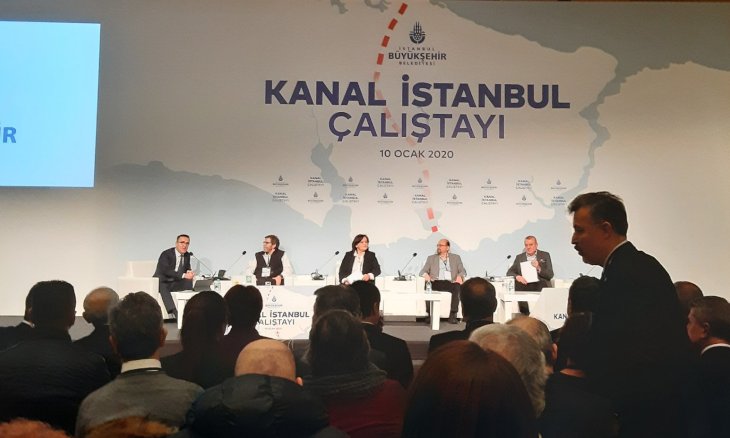Kanal Istanbul to destroy marine life in Marmara and Black Seas, experts warn at workshop
A workshop on the potential effects of the controversial Kanal Istanbul project was organized by the Istanbul Metropolitan Municipality on Jan. 10. The project will lead to the destruction of marine life in the Marmara Sea and Black Sea and will increase the salinity of water resources, thereby harming agricultural lands, according to several panelists at the workshop.
Filiz Gazi / Duvar
The government's plan to build Kanal Istanbul, a 45-km shipping canal parallel to Bosphorus, will alter sea currents and temperatures, leading to the destruction of marine life in the Marmara Sea and Black Sea, experts warned during a panel organized by the Istanbul Metropolitan Municipality on Jan. 10.
Scientific studies suggest that the project will spark an anoxic state in the seas, which would leave Istanbul smelling of hydrogen sulfide, which has a characteristic odor of rotten eggs, they said.
“If this occurs, it will be irreversible, just like was the case in İzmit Bay,” said Cemal Saygın, an academic from the environmental engineering department of Ankara's Hacettepe University.
“If you ask what will happen to the fish [after the project], you will ask 'What kind of species were they?'” he said.
A total of 40 experts took the floor at simultaneously-held panels during the workshop. The discussions revolved around eight different themes.
Marmara Sea to suffer with extra population in Istanbul's north
New suburbs along the canal is expected to increase Istanbul’s population by over 1 million. Experts said that the ecosystem of the Marmara Sea cannot sustain its delicate balance any longer in the face of more people, as there are already small and fewer fish in the sea.
“If the population in Istanbul's north increases, the nitrogen and phosphorus level, which is already high, will increase further and the oxygen level in the water will decrease. This means the death of the sea,” said Ahsen Yüksek, an academic from Istanbul University's Institute of Marine Sciences and Management.

Derin Orhon, a professor from the environmental sciences and engineering department at Near East University, said that the project will end up increasing the salinity of underground streams, thereby harming agricultural lands.
“Some 140 million square meters agricultural lands will be destroyed. 23 million square meters of forests will be destroyed. The population will increase by 2 million. It will have a deadly impact on Terkos and Sazlıdere water resources,” Orhon said, referring to the Lake Terkos, which supplies water to Istanbul and the Thrace region, and SazlıdereDam, which is a reservoir dam in the Küçükçekmece district of Istanbul.
Doğanay Tolunay, a professor from the forestry department of Istanbul University, said that the project's environmental impact assessment (ÇED) report does not even indicate the extent of the construction. “Some 36,453 hectares of land will be opened for settlement. Some 201,000 trees will be cut down,” he said.
Sedat Kalem of World Wildlife Fund also took the floor on Jan. 10, urging the government to give up on the project. “The world is on the brink of extinction. Every drop of water, every piece of efficient land is valuable. We need to take an action knowing this,” he said.
'Istanbul should instead prepare for earthquake'
The workshop also focused on the project's implications for the megacity in the face of an earthquake. During the “Disaster Risk and Earthquake” panel, geologist and earthquake expert Professor Naci Görür said that instead of spending time and budget for the controversial project, the city – which sits on active fault lines – should be instead preoccupied with preparing for an earthquake. Experts have been constantly warning against a big earthquake in the Marmara region for the last decade.
“We think that the fault line under the Marmara [Sea] will break. The expected quake is forecasted to have a magnitude of a maximum 7.6. We have already announced this, but instead of preparing for the earthquake, we are discussing the Kanal project,” Görür said.
Asked what kind of a geological surface the Kanal is passing through, Görür said: “It is a clay surface, so a fluid and soft floor. It is a floor which the engineers are scared of [in terms of earthquake]. It goes through places which are rich in underground waters. As soon excavations start for the Kanal, there will be landslides, especially in the areas between Büyükçekmece and Küçükçekmece. This will happen before the earthquake. There are already landslides happening in that region,” he said.
Haluk Eyidoğan, a retired professor from the geophysical engineering department of Istanbul Technical University, said that the chance of Istanbul seeing an earthquake with a magnitude of 7 or above within the next 30 years is 65 percent. He also said that the Lake Küçükmece sits on three active fault lines, but there is no information about this in the project's environmental impact assessment report.
